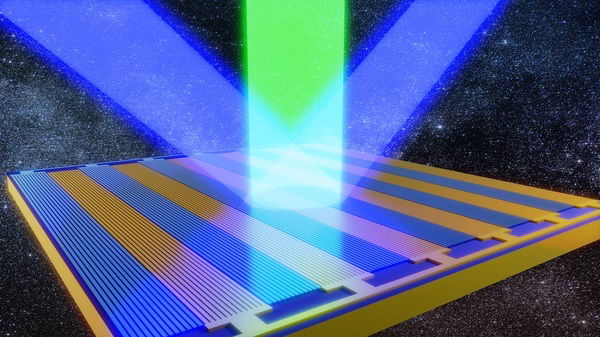
Imagine sitting in a coffee shop with a bunch of other laptop users.
Everyone is trying to load websites or stream high-definition videos, and all of you are craving more bandwidth.
Now picture each person having a dedicated wireless channel that is hundreds of times faster than today’s Wi-Fi, with much more bandwidth.
This dream might soon be a reality thanks to the development of tiny engineered sheets called metasurfaces, which can control light in amazing ways.
In a paper published in the journal Nature Nanotechnology, a team of engineers from Caltech has developed a metasurface with tiny, tunable antennas capable of reflecting incoming beams of optical light to create many new channels of different optical frequencies. This means one beam of light comes in, and multiple beams go out, each with a different frequency and direction.
Harry Atwater, a senior author on the paper and professor at Caltech, explains, “With these metasurfaces, we can show that one beam of light comes in, and multiple beams of light go out, each with different optical frequencies and going in different directions. It’s like having an array of communication channels. And we found a way to do this for free-space signals rather than signals carried on an optical fiber.”
This breakthrough points to the potential for a new type of wireless communication channel, new range-finding technologies, and even new ways to relay larger amounts of data to and from space.
Prachi Thureja, a graduate student and co-lead author of the paper, explains that the word “metasurface” means “beyond surface.” Metasurfaces are designed to go beyond what conventional optical elements, like camera or microscope lenses, can do.
These devices are made with nanoscale antennas that can reflect, scatter, or control light. They can focus light like a lens or reflect it like a mirror by strategically designing an array of tiny elements that change how light responds.
While previous work with metasurfaces focused on creating passive devices with a single fixed function, Atwater’s team has developed active metasurfaces.
“We can now apply different voltages to these devices and tune between different functions,” says Jared Sisler, another graduate student and co-lead author on the paper.
In their latest work, the team describes a “space-time metasurface” that can reflect light in specific directions and at particular frequencies. This device, just 120 microns wide and long, operates at optical frequencies typically used for telecommunications. These frequencies are thousands of times higher than radio frequencies, providing much more available bandwidth.
At radio frequencies, electronics can easily steer a beam of light in different directions, as seen in radar devices on airplanes. However, no electronic devices can do this at the much higher optical frequencies. The researchers had to find a new way, changing the properties of the antennas themselves.
The team’s metasurface consists of gold antennas with an underlying electrically tunable semiconductor layer of indium tin oxide.
By applying a specific voltage across the device, they can change the density of electrons in the semiconductor layer below each antenna, altering its refractive index (the material’s ability to bend light). This allows them to redirect reflected light at specified angles in real-time without needing to swap out any bulky components.
“We have an incident laser hitting our metasurface at a certain frequency, and we modulate the antennas in time with a high-frequency voltage signal. This generates multiple new frequencies, or sidebands, that can be used as high-data-rate channels for sending information.
We also have spatial control, meaning we can choose where each channel goes in space,” Sisler explains. “We are generating frequencies and steering them in space. That’s the space-time component of this metasurface.”
This metasurface can split and redirect light at optical frequencies in free space, rather than in optical fibers. It has potential applications in LiDAR, which uses light to capture depth information from a three-dimensional scene. The ultimate goal is to create a “universal metasurface” that can generate multiple optical channels, each carrying information in different directions.
“If optical metasurfaces become a widespread technology, a decade from now, you could sit in a Starbucks with many people on their laptops, and instead of each person getting a radio frequency Wi-Fi signal, they will get their own high-fidelity light beam signal,” says Atwater. “One metasurface could beam a different frequency to each person.”
The team is also working with the Optical Communications Laboratory at JPL, which aims to use optical frequencies instead of radio waves for space communication. This would allow sending much more data at higher frequencies. “These devices would be perfect for their needs,” says Sisler.
The paper, “Electrically tunable space-time metasurfaces at optical frequencies,” was published in Nature Nanotechnology. This groundbreaking work shows a promising path for the future of wireless communication and other advanced technologies.
Source: Caltech.



